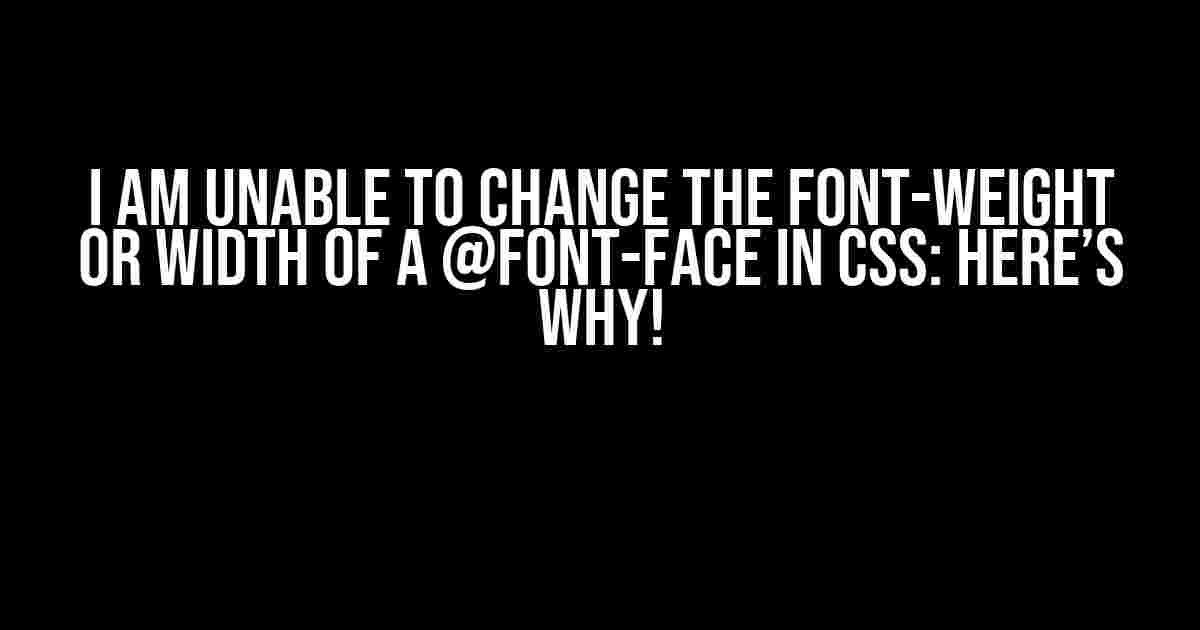If you’re reading this, chances are you’re frustrated because you can’t seem to change the font-weight or width of a @font-face in CSS. Don’t worry, you’re not alone! Many developers have been in your shoes, and it’s not because you’re doing anything wrong. In this article, we’ll explore the reasons behind this issue and provide clear solutions to get you back on track.
What is @font-face?
@font-face is a CSS rule that allows you to specify the location of a font file on your server, making it possible to use custom fonts on your website. It’s a powerful tool for adding personality to your design, but it can be a bit finicky at times.
The Problem: Inherited Font Properties
The root of the issue lies in how @font-face fonts inherit properties from their parent font. When you declare a @font-face font, it inherits the font-weight, width, and other properties from the original font file. This means that even if you try to override these properties using CSS, they won’t change.
@font-face {
font-family: 'MyFont';
src: url('myfont.woff2') format('woff2');
font-weight: normal; /* This won't work! */
font-style: normal; /* Neither will this! */
}
In the example above, the font-weight and font-style properties are declared within the @font-face rule, but they won’t take effect. That’s because these properties are inherent to the font file itself, not the CSS declaration.
Solutions: The Workarounds
Fear not, dear developer! There are ways to overcome this limitation. Here are a few workarounds to get you started:
Solution 1: Font File Modification
One approach is to modify the original font file to include the desired font-weight and width variations. This can be done using font editing software like Glyphs, FontLab, or even online tools like FontSquirrel.
Create multiple versions of your font file, each with a different font-weight or width. Then, declare each version as a separate @font-face font, like so:
@font-face {
font-family: 'MyFontThin';
src: url('myfont-thin.woff2') format('woff2');
}
@font-face {
font-family: 'MyFontBold';
src: url('myfont-bold.woff2') format('woff2');
}
@font-face {
font-family: 'MyFontWide';
src: url('myfont-wide.woff2') format('woff2');
}
This method requires some upfront effort, but it gives you precise control over the font variations.
Solution 2: CSS Font Synthesis
Another approach is to use CSS font synthesis to create artificial font-weight and width variations. This involves using the `font-synthesis` property to instruct the browser to generate the desired variations.
@font-face {
font-family: 'MyFont';
src: url('myfont.woff2') format('woff2');
font-synthesis: weight style; /* Generate bold and italic variations */
}
p {
font-family: 'MyFont', sans-serif;
font-weight: bold; /* The browser will generate a bold version */
font-style: italic; /* And an italic version */
}
Note that font synthesis is not supported in older browsers, so be sure to check the compatibility of this approach before implementing it.
Solution 3: Font Stacks and Fallbacks
A third option is to use font stacks and fallbacks to create the illusion of different font weights and widths. This involves declaring multiple fonts in a single font family, with each font having a specific weight or width.
@font-face {
font-family: 'MyFont';
src: url('myfont.woff2') format('woff2');
}
@font-face {
font-family: 'MyFontBold';
src: url('myfont-bold.woff2') format('woff2');
}
@font-face {
font-family: 'MyFontWide';
src: url('myfont-wide.woff2') format('woff2');
}
p {
font-family: 'MyFont', 'MyFontBold', 'MyFontWide', sans-serif;
font-weight: bold; /* The browser will use MyFontBold if available */
font-width: 100; /* The browser will use MyFontWide if available */
}
This method requires some clever font selection and ordering, but it’s a viable solution for creating the desired font variations.
Conclusion
In conclusion, changing the font-weight or width of a @font-face in CSS can be a bit tricky, but it’s not impossible. By understanding the underlying reasons behind this limitation and employing one of the workarounds mentioned above, you can achieve the desired font variations for your website.
| Solution | Description |
|---|---|
| Font File Modification | Create multiple font files with different weights and widths |
| CSS Font Synthesis | Use CSS to generate artificial font-weight and width variations |
| Font Stacks and Fallbacks | Declare multiple fonts in a single font family with different weights and widths |
Remember, each solution has its pros and cons, so be sure to choose the one that best fits your project’s requirements. Happy coding!
Frequently Asked Question
Stuck with styling your @font-face? We’ve got you covered! Here are some frequently asked questions about changing the font-weight or width of a @font-face in CSS.
Why can’t I change the font-weight of my @font-face?
This might be because the font file itself doesn’t support font-weight variations. Make sure to check the font file’s documentation or try using a different font file that supports varying font-weights.
Do I need to declare font-weight and font-width in the @font-face rule?
No, you don’t need to declare font-weight and font-width in the @font-face rule. These properties are used to style the text, not to define the font itself. Instead, use them in your CSS selectors to style your text.
Can I use font-variation-settings to change the font-weight or width?
Yes, you can use font-variation-settings to change the font-weight or width, but only if the font file supports OpenType font variations. This is a more advanced approach and requires a good understanding of OpenType font variations.
Why doesn’t font-weight work on my @font-face, but font-style does?
This might be because the font file only provides a single weight, but multiple styles (e.g., italic, oblique). In this case, font-weight won’t work, but font-style will. Check the font file’s documentation to see what variations are supported.
Can I use JavaScript to change the font-weight or width of a @font-face?
Yes, you can use JavaScript to change the font-weight or width of a @font-face, but it’s not recommended. CSS is the preferred way to style text, and using JavaScript for this can lead to performance issues and increase complexity.
